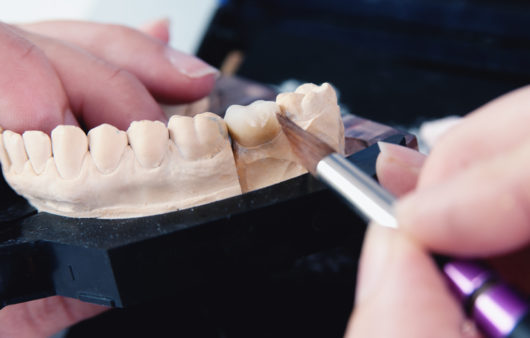Caps, crowns, and bridges are essentially all the same thing. A cap/crown is usually the best way to deal with a chipped tooth. If too much of the tooth is gone to support a filling, Dr. Stone envelopes the tooth with porcelain, metal, or a combination of these two substances. This procedure both strengthens and beautifies the tooth. So, a crown on teeth is basically two prosthodontic procedures in one.
A dental bridge is two crowns with a false tooth in between them. The result is something very similar to removable dentures. A bridge is a very good option for people missing teeth in certain parts of the mouth, who have undergone major trauma, and/or are not good candidates for dental implants.
The Crown on Teeth Procedure
Simply placing a crown in a gap is usually not an option. The mouth cannot tell the difference between a helpful substance, like a metal cap, and a harmful substance, like tartar. However, Dr. Stone must often remove quite a bit of the tooth to prepare it for a crown. Leaving the remaining tooth exposed is a very bad idea.
So, Dr. Stone usually creates a temporary crown made of acrylic. The temp crown looks good and functions well while the lab makes the permanent crown. Typically, patients can wear a temporary crown for up to three months. That’s plenty of time to prepare the permanent crown.
There are a lot of options in terms of cap, crown, and bridge material. Currently, it’s quite popular to combine porcelain with zirconium. Zirconia crowns are quite strong, rather inexpensive, and easy to fit. However, zirconium is not translucent, which explains the need for a porcelain supplement.
Recent Innovations
Milled crowns have been around since the early 1990s. They are better than ever now, and they may soon replace the porcelain/metal crown on teeth combination.
The material is easy to work with. The milled crown starts as a block which a computer-controlled laser then cuts into the shape of a tooth. Then, Dr. Stone cements the cap into place. This all takes place in the office during one visit. But there are still some problems. The milled crown failure rate is not high, but it is higher than the porcelain/metal failure rate.
Milled crowns are a microcosm of our philosophy. There have been a lot of prosthodontic innovations recently. But just because something is new does not necessarily mean it is better. Very soon, the milled crown disadvantages should be ironed out. But for now, this particular crown on tooth procedure remains more of a rare option in some cases.
By whatever name they’re called, caps, crowns, and bridges are a very good option for many patients who want a minimally-invasive and long-term solution for broken teeth. To see which approach is right for you, reach out to Best Dental Associates in Ft. Lauderdale for your initial consultation with Dr. Stone.
https://www.ncbi.nlm.nih.gov/pubmed/21889006




